1951: Cave In at Waiuta
January 27, 2021
By AHNZ
Waiuta gold mine (est c.1905) was the West Coast’s last great gold discovery and the second most valuable mine ever. It never ran out of gold but I think it might have run out of political favour.
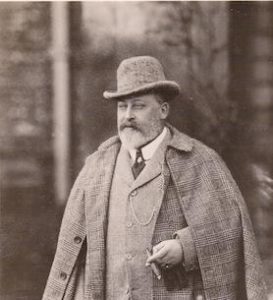 In July 1951 a shaft collapse was never recovered from so the mine shut and Waiuta withered to a ghost town you can still visit today (I know, I just did!) When the mine collapsed and flooded it was during the reign of National 1.0 who had declared a State of Emergency over striking Watersiders. You can be fairly confident of whose side the Waiuta miners on the West Coast were on and it wasn’t Prime Minister Sydney Holland’s and his Government.
In July 1951 a shaft collapse was never recovered from so the mine shut and Waiuta withered to a ghost town you can still visit today (I know, I just did!) When the mine collapsed and flooded it was during the reign of National 1.0 who had declared a State of Emergency over striking Watersiders. You can be fairly confident of whose side the Waiuta miners on the West Coast were on and it wasn’t Prime Minister Sydney Holland’s and his Government.
9 November, 1905: Discovery of the ‘Birthday Reef’ at Waiuta by prospectors. Also, King Edward’s 64th birthday.
1908: Waiuta fully operational mine with a growing company township, owned by Consolodated Goldfields of NZ Ltd.
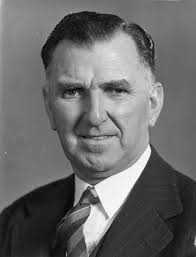 1949: National 1.0 win the general election
1949: National 1.0 win the general election
1930s: Population of Waiuta hits 600 with many ammenities. Union hall, shops, miners hall, hospital, recreation grounds, all-weather road, hotel, school, churches, swimming pool,..¹
February 1951: Waterfront Strike rears up again, national State of Emergency. Waiuta’s miners know whose side they are on.
5 June 1951: Snap election called. The Great Strike folds, defeated.
9 July 1951: Blackwater shaft, the main source of clean air in and water out of Waiuta’s mines, collapsed. After failed repair attempts the town and its capital now became as a beached whale. Salvaged for parts and scrapped for materials, the community exodus was under way.
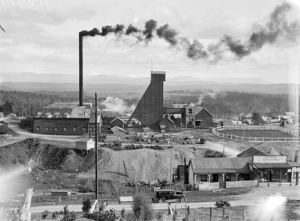 My view is that Holland let Waiuta die since, after all, it was a Labour stronghold and Labour source of for political cashflow. What votes were there at Waiuta for a National politician? Indeed, not so long ago, Keith Holyoake (up the road a bit) had to abandon his home electorate for another in the North Island due to the Red Wave. As recently as July 1951, Waiuta’s mining union would have been right in behind at biting the hand of Holland and his government. In June 1951 they were flat on the mat and either in need to political help or at least to be left alone to make repairs; Instead came a death blow.
My view is that Holland let Waiuta die since, after all, it was a Labour stronghold and Labour source of for political cashflow. What votes were there at Waiuta for a National politician? Indeed, not so long ago, Keith Holyoake (up the road a bit) had to abandon his home electorate for another in the North Island due to the Red Wave. As recently as July 1951, Waiuta’s mining union would have been right in behind at biting the hand of Holland and his government. In June 1951 they were flat on the mat and either in need to political help or at least to be left alone to make repairs; Instead came a death blow.
“The mine employs 110 men- much below the desired manpower, but the maximum number available under present labour conditions…The mine has recently been producing 400-500 ounces of gold per month. Before labour difficulties became acute, production had reached 2,000 oz per month…”- Greymouth Evening Star, 17 July 1951; Hutchison (1986)
“Up until yesterday, men were still entering the mine and working short shifts, but this ceased following an inspection by the district inspector of gold mines, GW Lowes.”- 18 July, ibid
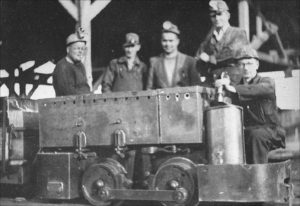 A politician will re-start a revenue stream (eg a mine) if it pays into his interests but above all he must kill the revenue sources of his rival party even if that means perfectly viable industries and firms must be destroyed. I’m sure it was a similar story with the Thames goldfields in 1914 when they suffered a similar collapse and flooding. William Massey’s Government owed no allegiance to an electorate and cash cow of the Liberal Party so that was the end of that too.
A politician will re-start a revenue stream (eg a mine) if it pays into his interests but above all he must kill the revenue sources of his rival party even if that means perfectly viable industries and firms must be destroyed. I’m sure it was a similar story with the Thames goldfields in 1914 when they suffered a similar collapse and flooding. William Massey’s Government owed no allegiance to an electorate and cash cow of the Liberal Party so that was the end of that too.
Unlike all that gold still sitting deep under the Coromandel there is a brand new plan to go back to Waiuta and mine once more….
“A new goldmine on the West Coast will begin construction in September with the promise of 140 jobs over 10 years….The mine is at the abandoned township of Waiuta and was mined successfully from 1908 to 1951. The funding includes a $15 million loan from the Government’s Provincial Growth Fund”- New Reefton gold mine promises to provide ‘many opportunities’ for locals; Stuff (20 Aug 2020)
The Waiuta reboot has been in development for some months. I assume further advances have depended on Labour 6.0’s re-election and now that’s done we will see some progress announced soon. Probably hinges on Megan Woods and Damien O’Connor getting some good payola and photo opportunities so once that’s settled some actual productive activity can begin.
Image ref. Waiuta 1931; Jos Divis; Alexander Turnbull Library
Image ref. Locally designed and manufactured battery-electric powered rail engine used for hauling quartz trucks in Waiuta mine, New Zealand circa 1939; NZ History and Natural History, Facebook
11 thoughts on "1951: Cave In at Waiuta"
Leave a Reply
 Like Comment Share
Like Comment Share

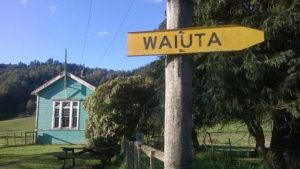
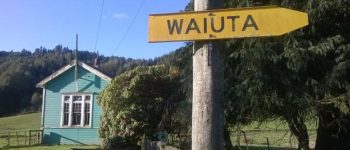




Could you please call me regarding this link.
Friends of Waiuta Inc
Margaret E Sadler
President.
T 03 768 7118 / cell 027 237 0794
E. waiuta1951@gmail.com or margsadler@xtra.co.nz
P.O.Box 493
Greymouth 7840
Had attributed the photographer but did that at the foot of the post so you may have missed it.
If you can find out some evidence to back up your idea that closing the mine was a decision by the company in London I’d be happy to take a look. My source comes from one of the Friends of Waiuta publications.
If only we had the Grey River Argus for 1951 it would answer so many questions!!!
Good morning,’
I am researching my family and am aware that one of my relatives was in the party of four that discovered the reef at Waiuta.
I did have Helen BOOTH’s book on the BANNAN family but can’t find it. The discovery is covered in this book and there is a photo of the party in it.
Can you help me with this?
Thanks for asking.
‘The Bannan family : 122 years in New Zealand’ by Helen Mary Bannan Booth (1987) is an 87 page self-published manuscript. You can borrow a copy from various libraries such as the Auckland Public Library. She lived in Howick so I expect its in that library’s heritage collection…
“Descendants of Joseph Bannan, the eldest son of George and Ann Bannan, who was born in Dublin, Ireland in 1805 and died 1865. He married Rose Eliza Thompson Black, daughter of James Logi and…”
Might be an idea to approach the Friends of Waiuta people and ask what they’ve got on the Bannans. If you go to Waiuta I think that reef they found is marked out with a display panel that might even have a photo of those prospectors. I doubt I took a photo but I remember looking at the side of the hill and thinking ‘yeah, right’o then.’
“A small prospecting group discovered a gold-bearing quartz reef near the upper reaches of Blackwater Creek, a tributary of the Grey River, on 9 November 1905. As the discovery was made on King Edward VII’s birthday, it was loyally named the Birthday Reef.” Ref. https://nzhistory.govt.nz/
Update: Ernest Bannan is mentioned on the metal plaque at Birthday Reef.
Update: Check out this link and you can see Ernest’s brothers representing him 25 years after the discovery. pg.4
https://www.mininghistory.asn.au/wp-content/uploads/9.-Hill.Article-9.Vol-42006.pdf
Thank you to those who replied, I have since found Helen’s book and with her permission will transcribe it and update it.
Nice one. If you’ve got further exciting information about finding the reef I’d be keen to hear about it. Also interested in the closing of the mine but that’s probably past your timeframe.
I visited Waiuta in 1960 with my parents and brother. The offices and other buildings were as the staff left them in 1952 as if they had walked out without closing the door. I can remember looking through the staff cards that recorded the details of the workers.
The infrastructure of the two shafts were still intact as were the abandoned houses.
It is my understanding that apart from a dozen or so residents the town was abandoned in a few weeks after the closing as there were plenty of job opportunities elsewhere at that time.
My father lived in Blackwater when young and spoke often of Waiuta.
There are still a couple of houses standing that you can walk right into. I think the next iteration was that the place became holiday batches. You wont regret paying a visit in the 2020s. If you have old photos people would love to see too.
Revelation I had about Waiuta and Denniston is that people loved living there despite the conditions; It was their territory. Also, that when the economic base of a community is gone that’s game over. Can’t run a town on welfare. Or, a country…
My parents Emily and Ashley Cosgrove, bought the Bannan house in the 1950,s, they propected all around the district, have many photos of the house. After my parents died, I inherited the property and had many holidays there for many years, sold it in in the around 2014 to a farmer in the Blackwater Valley, many memories and photos. Visited the place in february 2024.
Thanks for that. I visited earlier this month and checked out the Jos Divis restoration. Think I liked it better before.
Hi Valerie,
I have some photos of the time when my family owned the house. They moved to Reefton and then on to Christchurch.